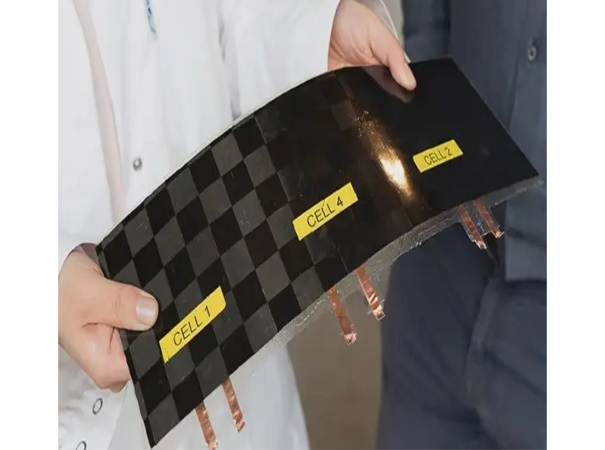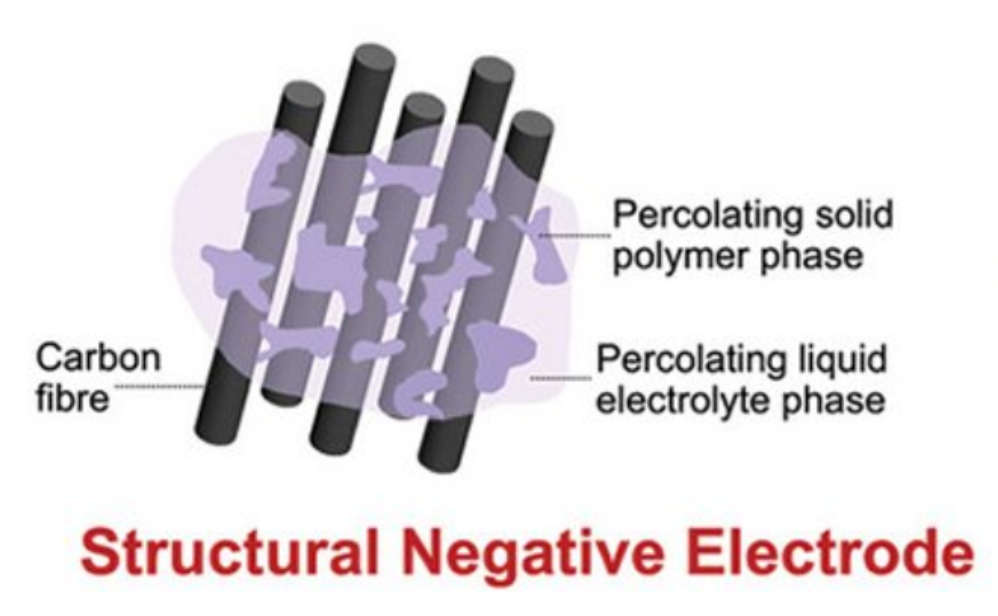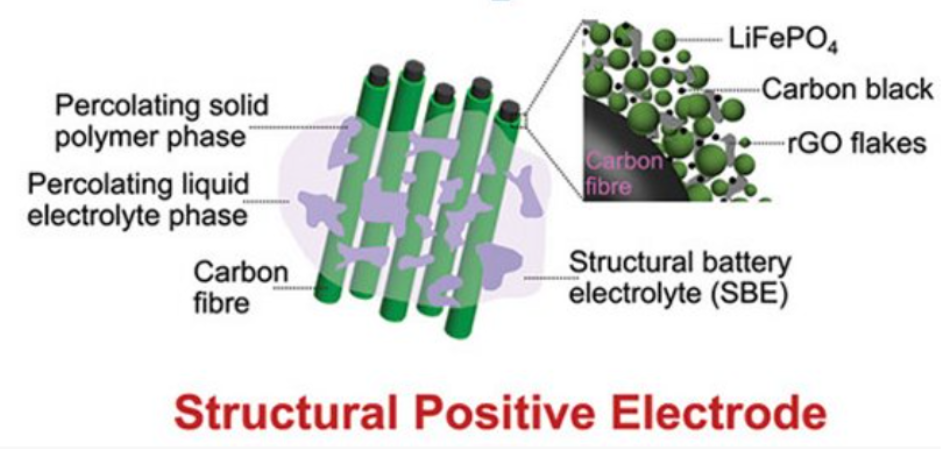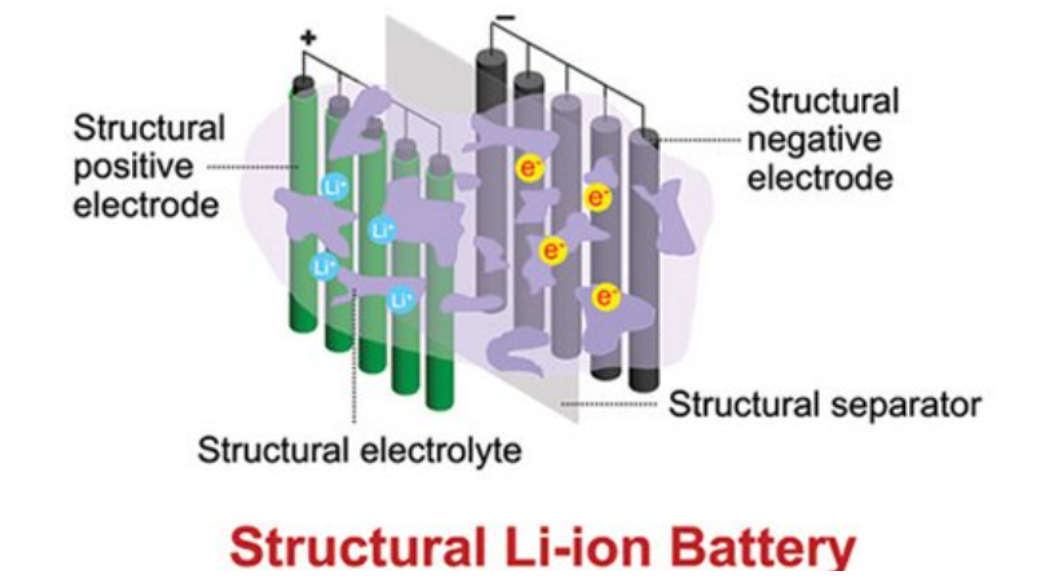Information
• 03/31/2025STRUCTURAL BATTERIES OF CARBON FIBER – “WEIGHTLESS”
Technological advancement in Sweden: carbon fiber batteries that do not add weight to cars, airplanes, or wind turbines.
Technological advancement in Sweden: carbon fiber batteries that do not add weight to cars, airplanes, or wind turbines.

Carbon fiber has long been considered a “miracle” material. It is as light as plastic but as strong as steel. It already has widespread applications in areas where extreme performance is essential, from Formula 1 to the aerospace industry. But what if, in addition to its exceptional mechanical properties, carbon fiber could also store and release energy like a battery?
This is the challenge taken on by a team of Swedish researchers from Chalmers University of Technology in Gothenburg, who, after years of studies, have achieved a remarkable breakthrough. What is it? Transforming carbon fiber into a true structural energy storage system, capable of being integrated into load-bearing components without adding weight or volume. A potentially disruptive technology that is now ready to take a major leap toward the market. From wind turbines to electric cars, and even the aircraft of the future, the possible applications seem endless.
A potentially disruptive technology that is now ready to take a major leap toward the market.
From wind turbines to electric cars, and even the aircraft of the future, the possible applications seem endless.
Let’s take a closer look at how this “invisible battery” works and how it promises to rewrite the rules of energy storage.
FROM AIRPLANES TO CARS, INCLUDING WIND ENERGY
The idea behind structural carbon fiber batteries is simple. It involves harnessing the intrinsic properties of this material to store energy, without the need to add extra components. In practice, it means transforming existing structural elements—such as an airplane fuselage or a car chassis—into fully integrated energy accumulators, thereby eliminating the weight and volume of traditional batteries.
A concept that, if implemented on a large scale, could revolutionize entire industrial sectors. Take aviation, for example, where weight has always been the number one enemy. Replacing heavy lithium batteries with structural components could make aircraft significantly lighter, increasing their range and reducing energy consumption. Or imagine the electric cars of the future, with battery-integrated bodywork capable of ensuring long ranges without sacrificing space or performance.
But that’s not all. Recently, researchers have also begun exploring the application of this technology in the wind energy sector. The idea is to integrate carbon fiber batteries directly into turbine blades, turning them into giant accumulators capable of storing excess energy generated during peak production hours. A solution that could help address one of the biggest challenges of renewable energy—its intermittent production.
In short, the potential applications seem truly limitless. And judging by the promises of Sinonus, the Swedish startup responsible for commercializing this technology, its market debut might be closer than you think.
BUT HOW DOES THE CARBON FIBER BATTERY WORK?
To understand the principle behind carbon fiber batteries, we need to take a step back and dive into the microscopic structure of this fascinating material.
Carbon fiber is composed of ultra-thin filaments of carbon atoms aligned in a particular crystalline configuration, which gives the material its extraordinary mechanical properties.

+

=

Well, researchers at Chalmers University discovered that by “playing” with the orientation and size of these crystals, it is also possible to modulate the electrochemical properties of carbon fiber.
In particular, they observed that fibers with small, poorly aligned crystals are excellent electrical conductors, though less rigid, while fibers with larger, more ordered crystals are stronger but less “battery-friendly.”
Finding the right balance between these parameters was the key to transforming carbon fiber into a truly “hybrid” material—one capable of offering both structural performance and energy storage capacity at the same time.
A result that, although it may seem obvious, required years of research and experimentation.
The real strength of structural batteries is not so much their energy efficiency but rather the ability to “hide” energy storage within already existing components, saving weight and volume at the system level.
Today, the team led by Professor Leif Asp, one of the world’s leading experts in the field, has successfully produced a carbon fiber battery with an energy density of 24 Wh/kg, approximately 20% of the best lithium batteries. And the prospects for the future are even more promising: according to ASP’s estimates, by further optimizing the design and materials, energy densities of 75 Wh/kg could be achieved, with rigidity comparable to aluminum.
The first studies gave birth to Sinonus, a startup dedicated to developing structural carbon fiber batteries.
Of course, we are still far from the performance of traditional batteries. But the true advantage of structural batteries lies not in energy efficiency alone but in their ability to “hide” storage within existing components, reducing weight and volume at the system level. On a large scale, this could make a significant difference in cost, size, and range.
Not to mention the safety benefits. According to researchers, the lower energy density and the absence of volatile substances would make carbon fiber batteries inherently safer than traditional accumulators—an important factor, especially in critical applications such as aerospace.

THE CHALLENGE OF MASS PRODUCTION
How long until we see the first practical applications of carbon fiber batteries? The main challenge lies in large-scale production.
For this technology to be truly competitive, it must leave the lab and face the realities of the market, proving that it can be produced in a cost-effective manner. It will need to hit the right price point, and cost remains the biggest hurdle at the moment.
Achieving this will require rethinking current production chains. Carbon fiber is still a niche material, primarily used in high-end applications such as aerospace and motorsports. To make it affordable for mass applications, significant cost reduction and process optimization will be necessary.
However, this challenge does not seem to intimidate Sinonus, which claims to be ready to take on the market with an ambitious and well-defined strategy.
IF THEY SUCCEED, IT WILL BE A GAME-CHANGER
This could lead to a revolution: wind turbines that double as energy accumulators, ultra-light aircraft with “energy-storing” fuselages, and electric cars with bodies that also function as batteries.
As Arthur C. Clarke once said, “The science fiction of today is the reality of tomorrow.” A reality of clean, integrated, and “invisible” energy, capable of powering our future without compromising it.
One day, as we watch an electric car silently whizzing by or an airplane soaring through the skies, we may find ourselves thinking: "Did you ever imagine they would be able to turn the body and cabin into a battery?" And that will only be the beginning.
Source: Gianluca Riccio, Creative Director at Melancia Adv, writer, and journalist. She is a member of the Italian Institute for the Future, the World Future Society, and H+. Since 2006, she has been leading Futuroprossimo.it, the Italian resource for futurology.









